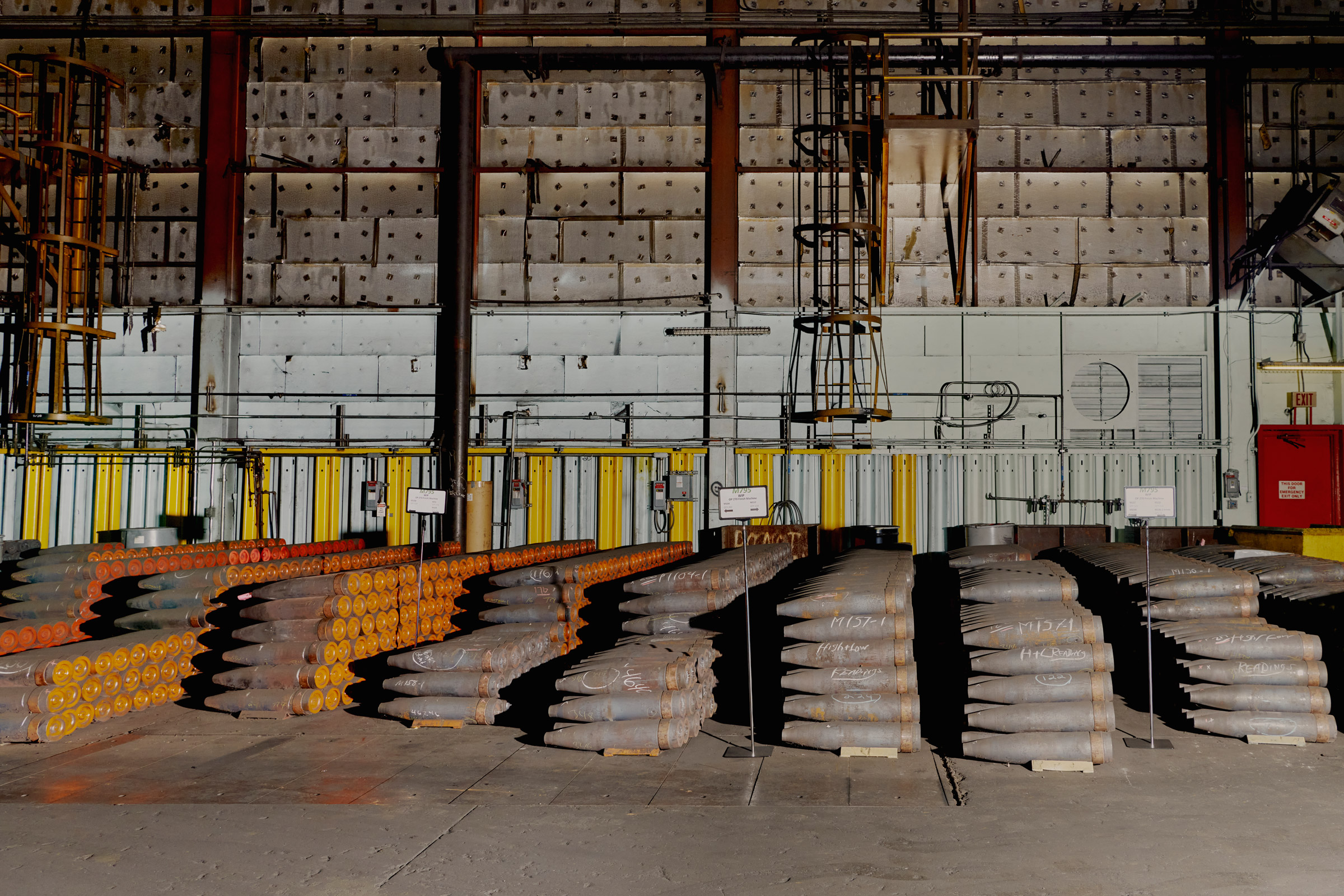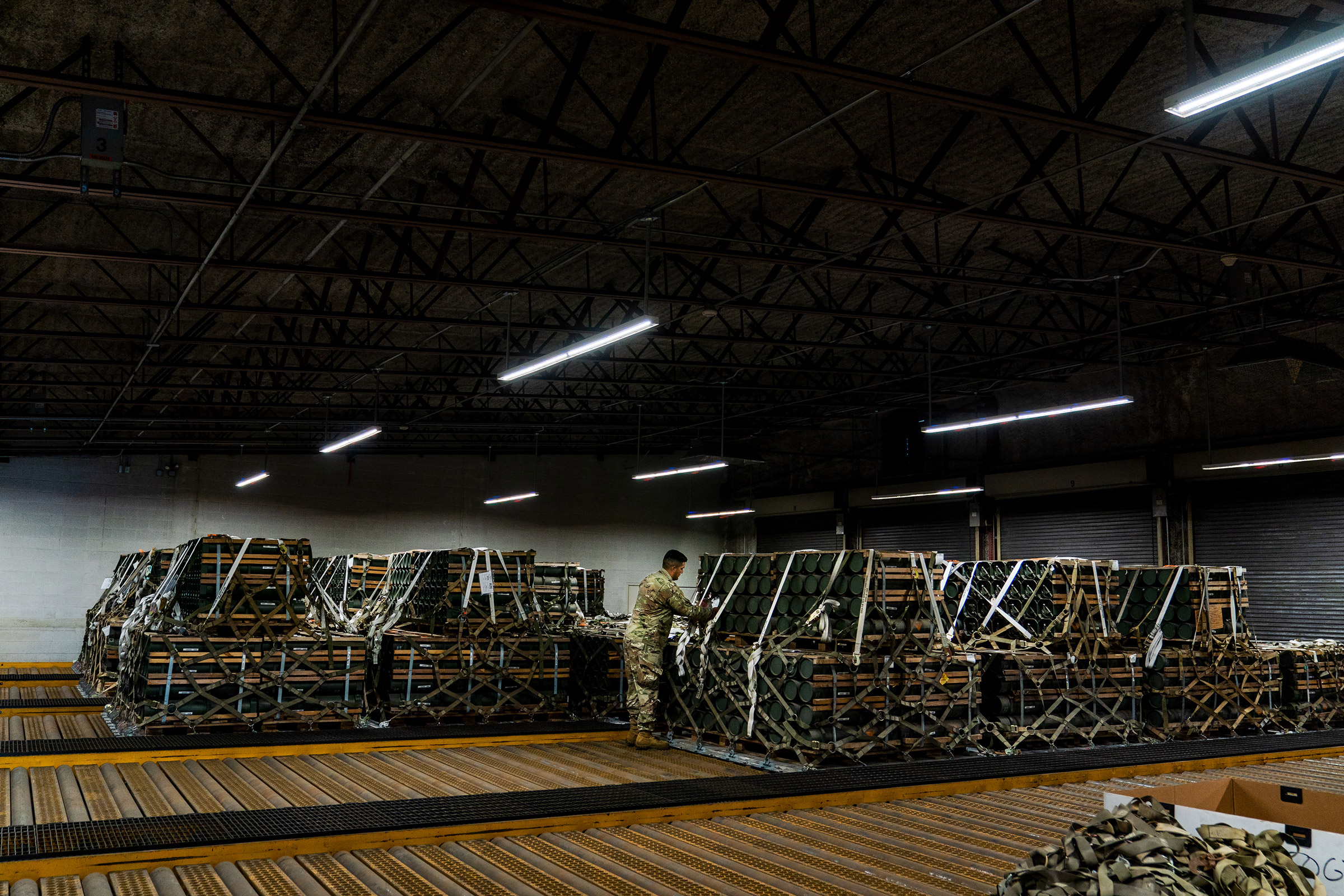Squinting at his computer screen through wire-rimmed glasses, Greg Hartl monitors an unmarked 18-wheeler as it cuts through the American heartland. Data from the truck’s satellite tracking devices stream into his windowless command center at Scott Air Force Base, about 20 miles east of St. Louis, showing Hartl each stop the driver makes and the weather and road conditions ahead. Most important, as the driver navigates rush-hour traffic and stretches of interstate alongside unknowing travelers, Hartl can track the condition of the volatile cargo: hundreds of high-explosive 155-mm artillery shells bound for Ukraine.
The race to supply Ukraine with the weapons it needs to win the war against Russia unfolds on Hartl’s glowing screen at U.S. Transportation Command (TRANSCOM) headquarters. As a branch chief with the Army’s Defense Transportation Tracking System, he watches each day as scores of trucks crisscross American highways, hauling antitank missiles, rocket launchers, air-defense systems, and artillery shells to air and naval bases. If a truck deviates from its route, or a bathroom break runs suspiciously long, Hartl is notified within seconds. “We have all sorts of alerts built in for high-risk shipments,” he says, stroking a graying, chest-length beard. “If they’re stationary for too long, we’ll get an alert. If the trailers become untethered, we’ll get an alert. If the trailer door opens, and it’s not supposed to, we’ll get an alert.”
Nothing quite like this ever has taken place before. For the first time, a country that’s outmanned and outgunned by a much larger invading foe is being openly armed and trained almost entirely by its allies. The Pentagon says the Ukraine supply mission is the largest authorized transfer of arms in history from the U.S. military to a foreign nation. More than 1,400 trucks, 230 planes, and 11 cargo ships ferried arms to Ukraine in the first four months of this year alone.



To understand how the U.S. and its allies are delivering this arsenal, TIME spent months speaking with dozens of people in the U.S. and Europe involved in planning, manufacturing, and distributing military aid for Ukraine. Those conversations, as well as visits to three states and three countries to observe different elements of the effort, revealed an operation that has overcome many of the challenges posed by supply-chain issues, diminished manufacturing capabilities, and international logistics to get Ukraine what it needs. But it remains an open question whether the mission can be executed quickly enough to ensure success on the battlefield.
Drawn-out decisionmaking processes in Washington and European capitals have slowed supplies. U.S. intelligence assessments released among the hundreds of classified documents leaked in April describe alarming shortcomings in Ukraine’s weapon stockpiles. Interceptors for some air-defense systems are due to run out by May, while the Ukrainian army’s position in the besieged eastern city of Bakhmut was deemed “catastrophic” amid Russian artillery bombardment. The disclosures confirm much of what President Volodymyr Zelensky and other Ukrainian officials have said for more than a year: their forces need more of everything, and fast.
The price tag for delivering it is staggeringly high. U.S. taxpayers have spent $35.4 billion on security aid for Ukraine since Russia invaded on Feb. 24, 2022—more than $3 million per hour. Some Republicans are asking how long that spending can continue. Strategic costs can’t be ignored, either. U.S. supply missions to the Pacific, the Middle East, or other parts of the globe are sometimes rescheduled because of the priority given to Ukraine, the military admits. “What’s challenging right now is just the volume of requirements, including the surge of requirements in Ukraine,” says Major General Laura Lenderman, director of TRANSCOM’s operations. “We’ll sustain the effort. But there is risk.”
More from TIME
The supply mission is now at a critical moment. After blunting a Russian push over the winter, the Ukrainian military is on the cusp of launching a counteroffensive against occupying forces. The American-made arsenal must reach the Ukrainians’ hands well in advance. If Ukraine can reclaim Russian-held territory, then its army could try to sever Russia’s land bridge to Crimea, setting optimal conditions for cease-fire negotiations. But if the counteroffensive sputters, opposition to indefinitely supporting the Ukrainians could intensify. The Biden Administration believes what happens in the coming months could shape the outcome of the war, and potentially the future of Europe itself.
Inside TRANSCOM’s Global Operations Center, six large flat screens display real-time information and maps showing the status of the day’s deliveries. It has the air of an immense theater with contractors, civilian analysts, and uniformed service members seated in rows. Information funneling nonstop into the encrypted computer network emerges as flowcharts, logistics models, and statistics for leaders to scrutinize. Decisions made in this room often have a domino effect on supply movements across the world.
Each evaluation depends on a range of information: inventories, supply systems, dates of deliveries, and consumption rates. The U.S. has deep and wide-ranging knowledge about the state of Ukraine’s military through daily information sharing. An internal Defense Department application, dubbed ADVANA, contains algorithms that map out logistics and calculate munitions rates, so the U.S. and allies can stay ahead of Ukraine’s needs. And among the most pressing issues throughout the war has been artillery supplies.
The U.S. spent the past two decades fighting wars with weapons enabled via information-age technology—satellites, sensors, and computer chips. The conflict in Ukraine more closely resembles the grinding trench warfare along the western front in World War I. It is fought largely in artillery duels, each side pounding the other with shells over long distances. Ukrainian artillery units face a deep disadvantage as the number of 152-mm shells for its aging Soviet-era artillery pieces has dwindled. The U.S. and European allies have provided Ukraine with newer 155-mm guns and shells, but it still isn’t enough. The Ukrainians have so few artillery shells that they’re rationing them, according to a letter Ukrainian Defense Minister Oleksii Reznikov wrote to European Union members in March. Reznikov’s forces fire around 3,000 rounds a day, he said, while the Russians fire four times as many.

Even so, Kyiv’s artillery consumption rate far outstrips American manufacturing capacity. The U.S. military has raided existing artillery stocks in Germany, South Korea, and Israel to keep up with Ukrainian demand. In all, the Biden Administration has already sent more than 1 million of the shells to Ukraine. “We’re about at the end of our stock of what we can send,” a senior U.S. defense official tells TIME. Allies in Europe have leaped to Ukraine’s defense as well. Two weeks after Reznikov’s letter, the E.U. announced a $2 billion deal to loot its own arsenals and send 1 million artillery shells over the next 12 months.
At the same time, the U.S. is revitalizing Cold War–era industrial facilities to produce weapons. “We haven’t seen production numbers like this in decades,” says Mark Cancian, a retired Marine colonel who’s now a senior adviser at the Center for Strategic and International Studies. “Changes like this have long-lasting effects.” Biden has invoked authorities under the Defense Production Act four times to mobilize U.S. private-production capacity for ammunition, missiles, and drones, while $2 billion is being set aside to help expand and modernize manufacturing facilities.
Read More: Inside the U.S. Army Plant Making Shells For Ukraine.
The Scranton Army Ammunition Plant in Pennsylvania finds itself at the center of this transformation. The Army acquired the facility in 1951 after it had been abandoned for several years, and converted it to manufacture artillery shells during the Korean War. Back then, the U.S. had 86 military ammunition plants as part of an industrial mobilization designed to meet wartime needs. Now it has just five. Roughly 300 employees work around the clock, five days a week, across the 15-acre complex of red brick buildings, where steam locomotives were repaired a century ago. I AM A BOMB TECHNICIAN, reads a black T-shirt on a machine operator’s chair. IF YOU SEE ME RUNNING TRY TO KEEP UP.
Batches of artillery rounds destined for the Ukrainian battlefield twist their way down a serpentine production line, through house-size furnaces heated to 2,000°F and industrial machinery that bends, stretches, and shapes the red-hot steel. “Don’t touch it,” warns Richard Hansen, who oversees manufacturing operations at the Scranton plant. “It won’t just burn your hand. It will take it off—bone and everything.”
Inundated by demand, the Pentagon doubled its production rate for 155-mm howitzer shells over the past year, from around 14,000 per month to 24,000 by year-end. It plans to hit 85,000 by 2028. “Speed is key,” Hansen says. Transforming a steel rod into an artillery shell takes about three days. But in peacetime, it could take several weeks before they’re loaded onto pallets and driven 10 hours away on a big rig to a plant in Iowa, where they’re filled with explosives and affixed with fusing—effectively converting them into oversize exploding bullets, ready to be fired from a howitzer.
In the race to get arms to Ukraine in time for the counteroffensive, every minute counts. Before the Russian invasion, it took four months for an approved $60 million arms package to reach Ukraine because of the bureaucratic and logistic hurdles. Deliveries on a deal like that can now take just four weeks or less. To speed things up, Congress has relaxed constraints on how the Pentagon buys arms, while the U.S. military has come up with new ways to package and supply them. Simple alterations have gone a long way. Air Force personnel have rebuilt pallets to allow for more artillery rounds and rearranged howitzers to squeeze a few more inside a C-17’s cargo hull, saving flights and time in the process.



For three weeks last spring, the military compelled trucking companies to prioritize artillery deliveries rather than hauling commercial goods to their destinations. It created “safe havens” at bases throughout the Midwest where truckers could drop their trailers loaded with consumer goods like televisions, sofas, and household cleaners in favor of those filled with artillery shells drawn from seven military depots around the country.
At Delaware’s Dover Air Force Base, trucks were backed up for miles onto a nearby highway, waiting to be off-loaded. Local law enforcement had to guide commuter traffic around snarls of delivery trucks. Inside the base, troops work around the clock loading idling cargo planes. The cargo, stacked on pallets, bore stickers with a European destination—often in Germany or Poland—where it’s later off-loaded and driven to the Ukrainian border.
Getting supplies to Ukraine wasn’t always so challenging. For years, the U.S. flew weapons and equipment into Kyiv directly. But when the capital was besieged, and Russian missiles were falling across Ukraine, the military arranged to deliver arms through European allies. Within days, dozens of cargo planes were landing on airfields near the Ukrainian border, packed to the brim with weapons.
The hulking, four-engine C-17 jets are the quickest way to get weapons to Ukraine, but they’re costly and take resources from other missions around the globe. So once the first set of deliveries was done, contractors took over. Since then, about two-thirds of TRANSCOM’s 1,177 flights for Ukraine have been handled by seven commercial cargo carriers that fly into nearby European countries, at a total cost of around $600 million. For deliveries that aren’t as time-sensitive, the arms are sent on cargo ships for a two-week trip from East Coast military terminals to seaports across the European continent.
Once in Europe, a whole new set of logistical challenges kick in as the U.S. arms-supply effort merges with those of scores of other countries. Arriving at airfields and seaports, freight is off-loaded and put on trains or trucks by local stevedores. Deliveries are vulnerable to weather delays, along with factors unrelated to the battlefield. In July, a German dockworkers’ strike impacted the handling of container and cargo vessels in ports. In March, train stations across Germany came to a standstill when tens of thousands of rail workers held a 24-hour walkout.
“Fortunately, I wasn’t affected by it,” says U.S. General Jacqueline Van Ovost, who at the time of the initial Russian invasion was barely four months into her role as TRANSCOM commander. Specific routes into Ukraine change often and are kept secret out of fear of Russian attack; Western officials say the main supply lines run through Slovakia, Romania, and Poland, requiring substantial coordination with allies. “We need to make sure that it’s smooth, like a ballet,” says Van Ovost.
Using a so-called presidential drawdown authority, Biden can transfer weapons and equipment from U.S. stocks without congressional approval, which speeds deliveries. Van Ovost has embedded members of her command inside the Pentagon and European headquarters to anticipate what will be on the President’s delivery list before it’s announced or signed. “Now I know about four weeks out what they’re thinking,” she says. “Initially, I was about 12 hours out.”
Read More: Why NATO Is Giving Ukraine Air Defense, Not Fighter Jets.
Coordinating the 54 nations in the Ukraine Defense Contact Group is its own challenge. The U.S. convenes a planning meeting every month or so to determine what weapons each country can provide. In November, the military set up a headquarters wholly dedicated to supporting Ukraine at Clay Kaserne in Wiesbaden, Germany. “There’s a daily dialogue between the U.S. team and the Ukrainian team on the ground,” says Laura Cooper, Deputy Assistant Secretary of Defense for Russian, Ukrainian, and Eurasian affairs, who has emerged as a point person on the military-aid mission, working with a small team inside the Pentagon.

Speaking to TIME on the sidelines of meetings between Defense Ministers at NATO headquarters in Brussels in February, Cooper described the work of the 54-country military-supply effort. Atop her agenda: a “priority list” based on the Ukrainian forces’ battlefield needs and the potentially available weapons systems from the West. The top three items on the list were artillery, armor, and air defense. Under each of those was an itemized set of weapons that would meet Ukraine’s needs. “We make sure that we are fielding [weapons] in time for the Ukrainians to make use of them on the battlefield in the coming months,” Cooper says.
Not every artillery shell from foreign stocks will be used on the battlefield in Ukraine’s coming counteroffensive. For months, Ukrainian forces have been firing them as part of their training for that assault. Russian forces hold some 20% of the country in the south and east, and have built three layers of defensive lines and antitank barriers running about 75 miles through eastern Zaporizhzhia province, British defense intelligence reported in April. Moscow expects a push on Melitopol, a key city that’s vital to Russia’s land bridge and critical supply lines stretching from the occupied regions of Donbas and Crimea.
The U.S. and its allies have played a central role in preparing Ukraine’s forces. About 4,600 Ukrainian soldiers have completed combat training, including two brigades equipped with American-made Bradley and Stryker vehicles. Ukrainian crews are in Germany learning to operate donated Leopard 2 tanks, and in Britain training on donated Challenger tanks. Ukraine has nine brigades made up of thousands of troops outfitted with new Western equipment, including 200 tanks, 152 artillery pieces, and 867 armored personnel carriers and fighting vehicles, according to one U.S. military assessment leaked online. All this hardware requires new tactics for Ukraine, which has followed Soviet-style sequential operations—barraging the enemy with artillery fire, then proceeding with a ground advance.
Read More: What To Expect From Ukraine’s Counteroffensive.
The new units are being trained in combined-arms techniques that synchronize artillery, armor, and infantry movements. Western artillery, rockets, missiles, drones, and other aid proved decisive in Kyiv’s prior counteroffensive last August, when Russian forces were pushed from the northeastern Kharkiv region and parts of Kherson in the south. The achievement raised hopes that perhaps the Ukrainians could defeat the Russians altogether. In the months since, however, the conflict has devolved into a stalemate, with blood-soaked battles that yield casualties measured in the thousands.
In February, U.S. Defense Secretary Lloyd Austin walked among the new weapons and troops at Germany’s sprawling Grafenwoehr base, the former site of Nazi training grounds, as the first class of 635 Ukrainian fighters drilled on artillery pieces and armored vehicles. The Ukrainians were two weeks into a five-week course, and Austin looked on as concussive, earth-shuddering blasts emanated from a M109 Paladin self-propelled howitzer. Ukrainian crewmen yanked olive-colored shells off the rack, loaded them into the firing chamber, and listened for the radio to crackle with another round of coordinates from a spotter miles away. Smoke billowed out of the barrel and drifted over the surrounding pine trees as the artillery shells whistled downrange toward the target area. With each shot, the blasts inched closer to the bull’s-eye. The team fired again. Then again.
In the days ahead, this arsenal and these hard-earned skills may prove decisive in the counteroffensive. And when that battle begins on the eastern front, the fate of more than Ukraine may hang in the balance.—With reporting by Julia Zorthian
More Must-Reads from TIME
- Breaking Down the 2024 Election Calendar
- How Nayib Bukele’s ‘Iron Fist’ Has Transformed El Salvador
- What if Ultra-Processed Foods Aren’t as Bad as You Think?
- How Ukraine Beat Russia in the Battle of the Black Sea
- Long COVID Looks Different in Kids
- How Project 2025 Would Jeopardize Americans’ Health
- What a $129 Frying Pan Says About America’s Eating Habits
- The 32 Most Anticipated Books of Fall 2024
Write to W.J. Hennigan/Scott Air Force Base, Ill. at william.hennigan@time.com